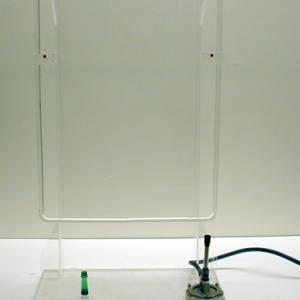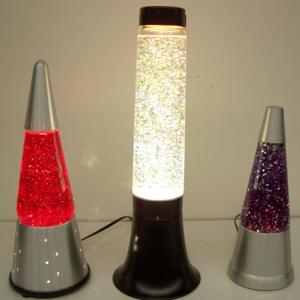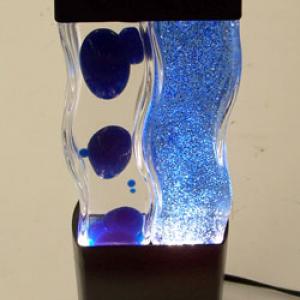College of Liberal Arts & Sciences
4B20.10 - Thermal Convection of a Liquid Demo
Fill the tube with water leaving enough room for several ml of coloring. Care is needed to see that undue strain is not put on the glass assembly when moving. The fastest convection is obtained when the burner is placed towards the corners of the apparatus. Quite a bit of coloring is needed to overcome dilution during convection. Note: Plexiglas will melt at around 300 degrees Fahrenheit. Be careful in your positioning of the Bunsen burner.
- Fernando F. Dall’Agnol, Rodrigo A. Antunes, Marcio R. Loos, and Daniel den Engelsen, "Counterintuitive Convection Flux Confined in a U-Shaped Tube", TPT, Vol. 57, #3, Mar. 2019, p. 184.
- S. Velasco, J. A. White, and F. L. Román, "Cooling of Water in a Flask: Convection Currents in a Fluid with a Density Maximum", TPT, Vol. 60, #1, Jan. 2010, p. 60.
- Richard J. Bohan and Guy Vandegrift, "Temperature-Driven Convection", TPT, Vol. 41, #2, Feb 2003, p. 76.
- Edward J. Carlone, "Convection Demonstrator", TPT, Vol. 21, #7, Oct. 1983, p. 464.
- Thomas B. Greenslade, Jr., "Convection Current Apparatus", AJP, Vol. 80, #7, July 2012, p. 647.
- "H-160. Liquid in Loop - Candle in Box", DICK and RAE Physics Demo Notebook.
- G. D. Freier and F. J. Anderson, "Hc-2", A Demonstration Handbook for Physics.
- Tik Liem, "The Confused Bottles", Investigation to Science Inquiry, p. 206.
- John Henry Pepper and Henry George Hine, The Boy's Playbook of Science, p. 383.
- David Kutliroff, "66, Convection Currents Made Visible with a Dye in a Glass Tube Filled with Water", 101 Classroom Demonstrations and Experiment For Teaching Physics, p. 146.
- Janice VanCleave, "27, One Will One Won't", Teaching the Fun of Physics, p. 43.
- Ron Hipschman, "Convection Currents", Exploratorium Cookbook III, p. 180.1 - 180.4.
- "Convection Currents", Science Snackbook, p. 28.1 - 28.2.
- Janice VanCleave, "Curls", 201 Awesome, Magical, Bizzare, & Incredible Experiments, p. 86.
- Curt Suplee, "How Heat Gets Around", Everyday Science Explained, National Geographic, p. 68 - 69.
- Julius Sumner Miller, Q153 & A153, Millergrams II – Some More Enchanting Questions for Enquiring Minds, p. 33 & 90.
- Joseph Frick, "# 375 - Conducting Power of Liquids", Physical Technics: Or Practical Instructions for Making Experiments in Physics and the Construction of Physical Apparatus with the Most Limmited Means, p. 451.
Disclaimer: These demonstrations are provided only for illustrative use by persons affiliated with The University of Iowa and only under the direction of a trained instructor or physicist. The University of Iowa is not responsible for demonstrations performed by those using their own equipment or who choose to use this reference material for their own purpose. The demonstrations included here are within the public domain and can be found in materials contained in libraries, bookstores, and through electronic sources. Performing all or any portion of any of these demonstrations, with or without revisions not depicted here entails inherent risks. These risks include, without limitation, bodily injury (and possibly death), including risks to health that may be temporary or permanent and that may exacerbate a pre-existing medical condition; and property loss or damage. Anyone performing any part of these demonstrations, even with revisions, knowingly and voluntarily assumes all risks associated with them.


